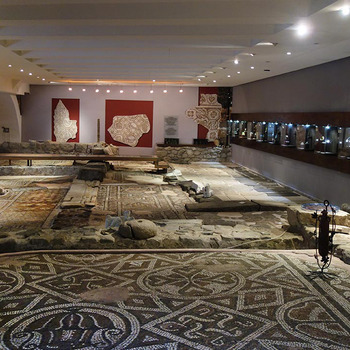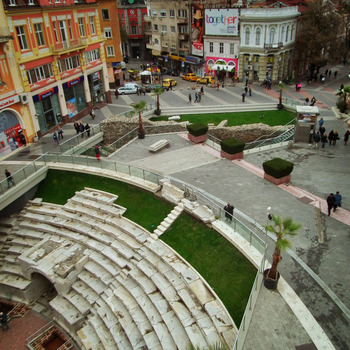Dzhumaya Mosque
Overview
Dzhumaya Mosque is a medieval Muslim temple in Plovdiv. The mosque is located in the city center, at the foot of Taksim Tepe. It is an early Ottoman monument, the dating of which is disputed - according to various authors, it was built under Sultan Murad I (1362-1389) or Sultan Murad II (1421-1451). Originally called the Muradie Mosque after Sultan Murad, who financed its construction, it later became known as the Ulu Dzhumaya Mosque ("Main Friday Mosque").
According to some researchers, the Dzhumaya Mosque was built on the site of an earlier Christian church dedicated to St. Petka of Bulgaria, built after the passage of its relics through the city in 1228. In the 19th century, Lyuben Karavelov wrote that the mosque "was once a church." This hypothesis is based entirely on local legends and "cannot be supported by any data." Others completely reject it, as no repairs from an older building on the site were found during the 2006-2008 renovation that reached the foundations of the building.
In modern historiography there are conflicting opinions about the time of construction of the Dzhumaya mosque, as the original construction inscription of the building has not been preserved. According to the prevailing opinion today, the mosque was founded by Sultan Murad II, probably around 1433-1436. The 17th century Ottoman historian Abdurrahman Hibri testified in favor of this, as did the fact that in the 16th century the mosque did not have its own waqf, but was supported by the funds allocated by Murad II for the maintenance of the established religious and charitable institutions in Edirne. The architectural style of the building, similar to similar mosques in Bursa, Edirne and Sofia, as well as the complete reconstruction of the city during this period speak in favor of this dating.
The other hypothesis about the time of construction of the Jumayya mosque connects it with Sultan Murad I. It is based mainly on the information from the travelogue from the XVII century by Evliya леelebi, according to which “the Uludjamia inside the bazaar, which is filled with worshipers, was made by the conqueror of the city of Edirne, Gazi Khudavendigyar Murad I. If the Dzhumaya Mosque was indeed built during the reign of Murad I, before 1389, it is the oldest major Ottoman monument in the Balkans, preceding even the Eski Mosque in Haskovo (1395), the imaret of Evrenos Bey in Gyumyurjina, that of Bayazid in Dimotika ( 1395 or 1397) and the constructions in the old Ottoman capital Edirne.
In 2006-2008, the entire building was overhauled by the construction company Tashyapi with funds from the Greater Istanbul Municipality. The walls and pillars were reinforced. The roof is covered with new cladding. The upper part of the minaret, damaged by the 1928 earthquake, has been restored to its original appearance. Inside, two layers of painted decoration have been removed; the earliest surviving one has been discovered, probably dating from 1785, which has been restored and restored. The prayer pool has been removed. The attached wooden corner has been turned into a confectionery and premises for the Plovdiv Mufti's Office. The reconstruction materials are printed in a volume sponsored by the Istanbul municipality, which is distributed free of charge.
The mosque is 40 by 30 meters in size and is located in the center of today's pedestrian zone, west of the old town of Plovdiv. The walls are built with two layers of bricks alternating with one layer of cut stone; bricks are also placed vertically between the stone blocks ("cell construction"). This type of masonry was used on the Balkan Peninsula before the arrival of the Ottomans in the construction of churches and others. buildings (eg the Boyar House in Melnik). This suggests that the builders were probably local or Christian captives. The Green Mosque (Yeşil cami) in Iznik and the Hüdavendigâr cami in Bursa have similar masonry.
Initially, access to the prayer room (haram) was provided by two entrances. While believers entered the mosque directly through the east, the north, now serving as the main one, led from the market in front of the mosque to the interior of the building through a portal. Today the entrance from the east is walled up. During restoration work (1784, 1818) an additional west door was made, which is no longer used. The minaret is in the northeast corner.
Unlike later Ottoman single-domed mosques, in Dzhumaya the prayer room is covered with nine domes carried by four pillars in the center of the building. Under the middle dome there used to be a cement fountain made at the beginning of the 20th century, which served not so much for the ritual washing before prayer, but as a symbol of the obligatory courtyard for each mosque.
Recommended
- Ancient stadium of Philippopo
- Dzhumaya Park
- Shahbedinova Imaret Mosque


 Bulgarian
Bulgarian Romanian
Romanian



